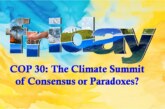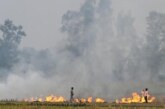
Dr. Arvind Kumar*

Water scarcity has particularly emerged as a highly critical and contentious issue within South Asia, one of the world’s most dynamic regions and home to nearly 1.9 billion people. It sits precariously on the front lines of the global climate crisis. Partway through 2022 and this is already shaping up to be a year of devastating climate impacts affecting lives and livelihoods around the world from disastrous flooding in Bangladesh to Pakistan, scorching heat waves in South Asia and Europe. As per UNDP estimates, around 2.5 billion people in South Asia alone, will be affected by water stress & scarcity by 2050. In Afghanistan, farmers face a second year of climate-induced drought, its worst in decades, at a time when nearly 19 million Afghanis are unable to feed themselves. In 2020, tropical Cyclone Amphan, one of the strongest cyclones ever recorded; displaced nearly five million people across India and Bangladesh. Its high time we understand the climate crisis is a water crisis.
This shows that there is an immediate need for international and regional partnership, reassessment of development models, mainstreaming untended local knowledge and highlighting climate finance at the forthcoming UN’s Climate Change Conference (COP27) in Egypt.
According to the assessment of the Intergovernmental Panel on Climate Change (IPCC) on the vulnerability of India to climate change, key challenges are most likely to be surface warming, a rise in sea level, decreasing water availability due to glacial retreat, significant reduction in crop production and a loss of flora and fauna. Water stress has various dimensions and even within countries or regions there are disparities in spatial distribution of the resource. Prolonged droughts, due to climate variability and change are exacerbating the situation.
Water needs to be a central part in all climate mitigation strategies and implementation. It should be at the forefront of all countries’ Nationally Determined Contributions (NDCs) because the vast majority of mitigation measures are impacted by water or have an impact on water. We cannot reach net zero without recognizing that water is central to protecting some of the largest carbon sinks such as wetlands, oceans and forests.
This indicates that there is a clear dissociation between water, society, governance and economy. Also, in many Indian cities, water is not properly distributed. Currently, we are interested in laying large networks, constructing huge storage dams, fetching water from 150 km and above, which involves a huge carbon footprint. We are valuing land more than water, neglecting our local water bodies, which have either gone dry or encroached.

There is a significant drying of springs, wetlands and oases around the world. Hotspots of groundwater depletion are found around the world, often in regions with intensive groundwater withdrawals for irrigation. The persistent decline in water levels, influences both aquatic and terrestrial ecosystems. Healthy wetlands act as a flood and drought defense for villages as well as megacities and securing agricultural yields. This includes growing drought resilient crops and adopting rain harvesting, along with smart irrigation techniques.
COP26 marked an important milestone in advancing the call for water resilience as part of climate adaptation. However, COP26 is not the finish line. It is, rather, an inflection point.
Hence at COP27 in Egypt; while it is important to track emissions, it’s now time to catch-up on impacts we have already locked in; it is also imperative for us focus that if climate change is everyone’s challenge, we need to recognize that a collective responsibility in tackling it must include providing resilient and safe water. Looking toward COP27 we have to continue to advance the transformation to water resilience—through both public policy advocacy and its leadership role in water stewardship.
A hard dose of honesty is what’s needed post COP26. It’s not just governments … we want net zero but do little in our lifestyles to deliver it; philanthropists want to save the world yet jet everywhere to space/COP/WEF/holiday homes; we want change but resist change… the list is endless. We are both the hero and hound; we just need the hero in us to surface right now. We just need a few good souls to step up to lead the charge on adaptation to waterproof our future. The writing is on the wall, seas are virtually certain to continue to rise – our only failure now is the failure to act!
*President, India Water Foundation



